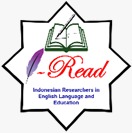The Secondary Education Students’ and Teachers’ Perspectives on EMI
DOI:
https://doi.org/10.22219/englie.v3i1.19793Keywords:
English-medium instruction (EMI), Perspectives, Secondary Education, Teaching and Learning ProcessAbstract
English-medium instruction (EMI) has become popular and developed as a growing global phenomenon nowadays in International secondary education in Indonesia. By comparison to this phenomenon's rapid growth, the EMI has not indicated immediate effectiveness in its application, in particular. The purpose of this research was to investigate the perspectives of students and teachers of the implementation of EMI at an Indonesian International school called Thursina IIBS Malang and to suggest ways to maximize the advantages of the policy while decreasing its disadvantages. To examine in-depth views and experience of the policy, structured interviews were conducted with 8th graders and academic teachers who were chosen purposively. Focus group discussion (FGD) was then employed to triangulate the data. The interview and FGD results showed that both students and teachers demonstrated strong acceptance of the policy because EMI could facilitate the teaching and learning process better and improve their English skills. However, in the EFL context, it was inevitably difficult to use English fully in the classroom where EMI naturally should be implemented fully in no other languages than English. Therefore, this study is expected to provide suggestions from the perspectives of EFL practitioners to maximize the benefit of the EMI policy in an EFL context.
Downloads
References
Chang, Y. (2010). English-medium Instruction for Subject Courses in Tertiary Education: Reactions from Taiwanese Undergraduate Students. Taiwan International ESP Journal, 2(1), 53-82. https://doi.org/10.6706/TIESPJ.2010.2.1.3
Chapple, J. (2015). Teaching in English is not necessarily the teaching of English. International Education Studies, 8(3), 1-13.
Cheung, Y. L. (2010). The Attitudes of University Students towards Non-native Speakers English Teachers in Hong Kong. RELC Journal, 38(3), 257-277. http://dx.doi.org/10.1177/0033688207085847
Creswell, J.W. (2013). Qualitative Inquiry & Research Design: Choosing Among the Five Approaches. Thousand Oaks, CA: SAGE Publications, Inc. (pp. 77-83)
Dardjowidjojo, S. (2003). English Teaching: Where and How Do We Begin?. In Sukamto, ed., Rampai Bahasa, Pendidikan, dan Budaya: Kumpulan Esai Soenjono Dardjowidjojo. Jakarta: Yayasan Obor Indonesia, pp. 29-40.
Dearden, J. (2014). English as a medium of instruction—A growing global phenomenon: Phase 1. London: British Council.
Greere, A., & Räsänen, A. (2008). Redefining ‘CLIL’ – towards multilingual competence. [LANQUA subproject on Content and Language Integrated Learning]. Retrieved from http://www.unifg.it/
Ibrahim, J. (2014). The Implementation of EMI (English Medium Instruction) in Indonesian Universities: its Opportunities, its Threats, its Problems, and its Possible Solutions. KATA, 3,7-10.
ISC (International School) Research. (2017). [online] https://www.relocatemagazine.com/articles/education-schools-the-changing-face-of-international-education-in-indonesia-apac1 [Accessed 16 Nov 2019].
Kym, I. & Kym, M. H. (2014). Students’ Perceptions of EMI in Higher Education in Korea. The Journal of Asia Tefl, 11(2), 35-61
Mardhavan, D., McDonald, J., & Paris, E. C. (2014, June 16). English as Medium of Instruction (EMI): Philosophies and Policies. OECD Higher Education Programme. http://www.oecd.org/education/imhe/Highlights-English-as-a-Medium-of-Instruction-webinar.pdf
Sivaraman, I., Al-Balushi, A. & Rao, D. H. (2014). Understanding Omani students‟ (University) English language problems. International Journal of Sciences: Basic and Applied Research, 13 (1), 28-35.
Simbolon, N. E. (2018). EMI in Indonesian Higher Education: Stakeholders’ Perspectives. TEFLIN Journal, 29(1), 108-128
Vinke, A. A., Snippe, A., & Jochems, W. (2010). English‐medium Content Courses in Non‐English Higher Education: a study of lecturer experiences and teaching behaviours. Teaching in Higher Education, 3(3), 383-394. https://doi.org/10.1080/1356215980030307
Vu, T. T. & Burns, A. (2014). English as a Medium of Instruction: Challenges for Vietnamese Tertiary Lecturers. The Journal of Asia Tefl, 11(3), 1-31
Wilkinson, R. (2010). English-medium instruction at a Dutch University: Challenges and pitfalls. In A. Doiz, D. Lasagabaster, & J. Sierra (Eds.), English-medium instruction at universities. Bristol: Multilingual Matters.
Downloads
Published
How to Cite
Issue
Section
License
Copyright (c) 2022 Dian Asmi Setoningsih

This work is licensed under a Creative Commons Attribution-ShareAlike 4.0 International License.
Authors who publish with English Learning Innovation (englie) agree to the following terms:
- For all articles published in English Learning Innovation (englie), copyright is retained by the authors. Authors give permission to the publisher to announce the work with conditions. When the manuscript is accepted for publication, the authors agree to automatic transfer of the publishing right to the publisher.
- Authors retain copyright and grant the journal right of first publication with the work simultaneously licensed under a Creative Commons Attribution-ShareAlike 4.0 International License that allows others to share the work with an acknowledgement of the work's authorship and initial publication in this journal.
- Authors are able to enter into separate, additional contractual arrangements for the non-exclusive distribution of the journal's published version of the work (e.g., post it to an institutional repository or publish it in a book), with an acknowledgment of its initial publication in this journal.
- Authors are permitted and encouraged to post their work online (e.g., in institutional repositories or on their website) prior to and during the submission process, as it can lead to productive exchanges, as well as earlier and greater citation of published work (See The Effect of Open Access).
This work is licensed under a Creative Commons Attribution-ShareAlike 4.0 International License.
















1.png)












